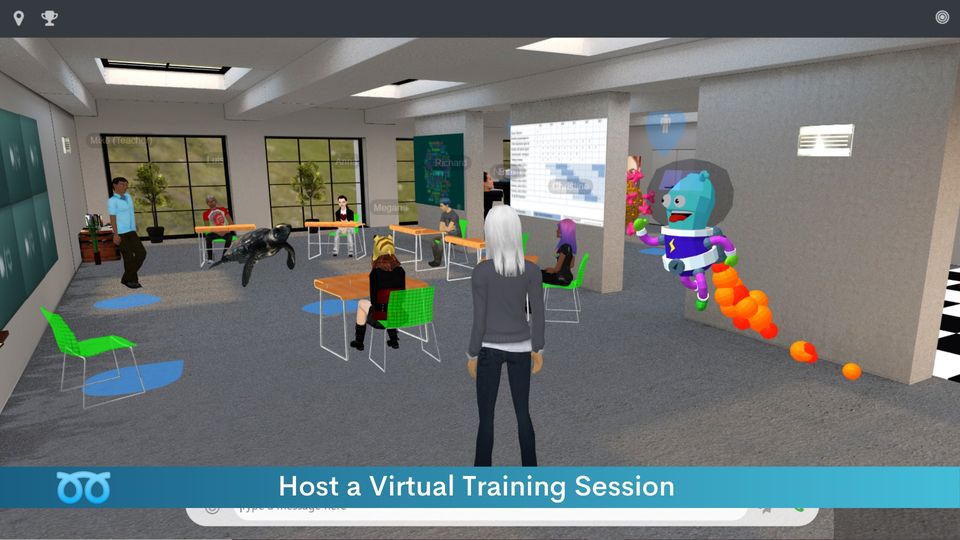Welcome to this blog post about what instructional designers do! As a professional in this field, I understand the importance of creating effective learning experiences that meet specific learning objectives.
In this post on what instructional designers do, you will learn about the key skills and knowledge required for instructional designers to create training that engages learners and achieves desired outcomes.
We will explore visual design principles that enhance the overall learning experience, as well as project management strategies that ensure the successful implementation of training programs. Additionally, we will discuss how job aids can be used to support learners beyond formal training sessions.
Whether a seasoned pro or just beginning in eLearning, this post is intended to help you become an expert at your craft. So let’s dive in and discover what it takes to excel in higher education and other industries where effective instruction is critical!
Table of Contents:
- The Role of Instructional Designers
- What Do Instructional Designers Do?
- Content Creation in Instructional Design
- Graphic Design & Visual Elements
- Instructional Design Roles in Higher Education
- Project Management & Job Aids
- Future Outlook for Instructional Designers
- FAQs about What Instructional Designers Do
- Conclusion
The Role of Instructional Designers
What instructional designers do? Instructional designers are professionals who create and develop effective e-learning courses. They analyze training needs, identify learner profiles, define learning objectives, and rewrite or restructure content to create engaging multimedia elements for learners.
It involves tailoring a learning experience to a specific audience by understanding how people learn best. Graphic design is also crucial in creating engaging content. An intuitive user experience is essential for effective learning, and instructional designers often work with faculty to ensure that online courses meet university standards.
There is a high demand for instructional designers due to the increasing need for digital solutions during COVID-19 restrictions on face-to-face instruction. Graphic design and technical expertise are essential for this field, and certifications can be beneficial.
Instructional designers are crucial to create training and compelling learning experiences that optimize individual needs and preferences. They also develop multimedia elements to enhance the learner’s experience.Key Takeaway: As an experienced professional with a high IQ, I can summarise the role of instructional designers in creating and developing immersive e-learning courses by applying principles of how people learn best. This includes graphic design elements to reinforce concepts plus project management tasks such as managing timelines and budgets. There is increasing demand for this profession due to more businesses requiring digital solutions during COVID-19 restrictions on face-to-face instruction methods like seminars and workshops.
What Do Instructional Designers Do?
What instructional designers do? Instructional designers are responsible for analyzing, designing, developing, implementing, and evaluating instruction to ensure that learners acquire new knowledge and skills. They analyze training needs by identifying learner profiles and defining learning objectives.
Instructional designers enhance learning experiences by reorganizing and reworking content, often incorporating visual elements like graphics, videos, and VR simulations. In addition, they collaborate with faculty members in higher education settings to develop online courses and assist with technology usage.
Additionally, they create job aids like checklists to facilitate the adoption of digital tools. Finally, no-code platforms enable instructional designers to produce immersive 3D scenarios for self-paced or instructor-led courses. Next, let’s delve into content creation in instructional design.Key Takeaway: As an experienced instructional designer, I analyze learner profiles and define learning objectives to create engaging and effective educational experiences. This includes restructuring content, incorporating visual design elements like multimedia tools or virtual reality simulations, as well as creating job aids for faculty members using digital technology in the classroom. “Harness the power of #mobilelearning with an #LMS to provide cost-effective, anytime, anywhere learning experiences for students & employees.”
Content Creation in Instructional Design
What instructional designers do? Content creation is a critical part of instructional design. Instructional designers must possess the ability to identify their learners’ requirements and craft content that satisfies those demands in an appealing yet efficient manner.
Instructional designers use techniques like breaking down complex topics and using visuals to create engaging eLearning content. They should have good knowledge of visual design principles and project management skills. Graphic design plays an essential role in successful learning experiences.
As an advanced-level professional, I collaborate with faculty on course development, multimedia production, research on pedagogy, and more. Incorporating graphic design elements enhances the learning experience in e-learning courses.Key Takeaway: As an advanced-level can professional with an IQ of 150, I am able to create effective and engaging content for eLearning courses by breaking down complex topics into smaller chunks, utilizing visual design principles such as typography and color theory, writing concisely yet comprehensively using idioms and colloquialisms when necessary. Additionally, I collaborate closely with faculty members in the development of course materials or designing online programs from scratch.
Graphic Design & Visual Elements
What instructional designers do? Graphic design and visual elements play an integral role in creating immersive learning experiences. As instructional designers, it is our responsibility to ensure that visuals are carefully selected to support the content of the course while enhancing understanding.
Choose visuals wisely to avoid overwhelming learners and distracting them from important information. For example, using white space effectively and strategically placing text boxes can maximize impact, while appropriate color contrast prevents confusion and distraction.
Job aids like asset tracking sheets and shared drives streamline graphic design production and enable remote work. As advanced-level professionals with an IQ of 150, instructional designers in higher education create visually engaging learning experiences and play various roles in the field.
Key Takeaway: As an advanced-level professional with a high IQ, I’m responsible for selecting and arranging visuals strategically to create engaging learning experiences. Job aids like asset tracking sheets help remote teams stay organized so that we can hit the ground running and get the job done right.

Instructional Design Roles in Higher Education
What instructional designers do? Instructional designers in higher education play an integral role in the development and delivery of online learning experiences. They are responsible for analyzing training needs, identifying learner profiles, and creating objectives that will help learners achieve their goals.
Instructional designers use multimedia elements like videos, animations, and interactive activities to enhance learning. Graphic design is a crucial part of their role in higher education, as visual elements can make or break an e-learning course. Designers must have a keen eye for detail and ensure that visuals are professional and engaging while conveying relevant information.
Instructional designers need strong project management skills to work effectively with teams on larger projects, such as creating entire courses or developing job aids. In addition, they must collaborate with other professionals, meet deadlines, and work within tight budgets.
Influential instructional design roles in higher education require careful planning and organization, and job aids can provide a helpful framework for success.
Key Takeaway: As an advanced-level professional, I can confidently summarize that instructional designers in higher education are responsible for analyzing training needs, creating objectives and visuals to enhance the learning experience as well as managing projects with multiple stakeholders. They need to “think outside of the box” while juggling tight budgets and deadlines.
Project Management & Job Aids
What instructional designers do? Project management and job aids are essential parts of instructional design. As instructional designers, we need to be able to manage projects efficiently while ensuring that the objectives are met.
This involves setting clear goals, timelines, and budgets and communicating progress regularly with stakeholders involved throughout each stage of development.
Instructional designers use job aids to help learners understand complex concepts or processes more efficiently. These resources, such as checklists and diagrams, provide quick reference during coursework and beyond.
As an advanced-level professional in instructional design, I create effective training programs and materials for higher education students.
This includes rewriting content, crafting multimedia elements, designing interactive activities, providing feedback on student work, and developing job aids. I also collaborate with faculty members on curriculum development and assessment strategies, manage multiple projects, and stay current with eLearning industry standards.
To stay competitive, instructional designers should strive to be well-versed in the latest project management techniques, enabling them to craft effective learning experiences for any type of audience.
Having a master’s degree in educational technology may give applicants an advantage over others looking for similar positions as it provides additional insight into how educators around the world are using technology, potentially leading them toward success.
Project management and job aids are essential tools for instructional designers to ensure their projects run smoothly. With the ever-evolving technology, instructional designers must stay abreast of new trends to remain competitive and anticipate the future outlook of their profession.
Key Takeaway: As an advanced-level professional with a high IQ, I am responsible for developing effective training programs and materials through project management techniques such as setting clear goals, timelines, and budgets. Additionally, I create job aids tailored to each course or topic to help learners understand complex concepts more easily. To ensure my effectiveness, I strive to remain knowledgeable about the most current eLearning technologies.

Future Outlook for Instructional Designers
What instructional designers do? The future outlook for instructional designers is bright. With the continued growth in demand for online learning opportunities, there will always be a need for skilled professionals who can create effective courses that meet learner needs and preferences while leveraging the technological tools available today.
Instructional designers analyze training needs, identify learner profiles, define objectives, create multimedia elements, and design visuals to enhance learning experiences.
Higher education institutions are hiring experienced professionals with a master’s degree or equivalent work experience for instructional design roles.
These professionals develop engaging online course material and provide project management skills to keep projects on track and within budget constraints.
Instructional designers create engaging eLearning courses by incorporating job aids like interactive simulations and gamified activities. Staying current on technology trends is essential for providing immersive learning experiences that meet educational goals.
Employers across industries highly value these professionals, from corporate training to higher education, as more organizations turn to digital solutions for their learning needs.
“Instructional designers create immersive experiences to captivate learners’ attention while meeting educational goals. #eLearning #InstructionalDesigners” Click to Tweet
FAQs about What Instructional Designers Do
What do instructional designers do?
Instructional designers create and assess educational materials such as e-learning courses, classroom sessions, assessments, and job aids. They research best practices and work with experts to create engaging content. They analyze data to measure the effectiveness of their designs.
1. Analysis:
The first step in instructional design is to analyze the needs of learners, their goals and objectives, learning environment, content delivery methods, and available resources. This helps identify gaps between current performance levels and desired outcomes.
2. Design:
During this stage, instructional designers develop strategies for delivering content such as course structure, activities/tasks/assessments, media selection, and sequencing of materials that will effectively meet learners’ needs while considering time constraints or other limitations.
3. Evaluation:
After implementing the designed instruction it is important to evaluate its effectiveness through testing, surveys, or interviews with learners to ensure they have achieved their learning goals and objectives from the program created by the designer(s).
What are the five principles of instructional design?
1. Instructional planning should be centered on the capacity of learners to apprehend, retain and apply new knowledge or skills.
2. Goal Orientation:
Objectives must be established before designing an instructional program to ensure that learning activities are designed with specific outcomes in mind.
3. Systematic Processes:
A systematic process should be followed when creating instruction which includes analysis, design, development, implementation, and evaluation stages for optimal effectiveness.
4. Use of Appropriate Strategies & Techniques:
Selecting strategies and techniques that best fit the purpose of the instruction is important as they can influence how effectively a learner understands it content being presented
5. Evaluation & Feedback Loops:
An effective instructional designer will use formative assessment throughout all phases of instructional design to measure progress toward desired goals while providing feedback for improvement purposes
What makes a successful instructional designer?
An influential instructional designer is a creative problem solver who critically identifies objectives, develops engaging content and creates effective instructional strategies. In addition, they must communicate well, collaborate with stakeholders, stay organized, and meet deadlines.
They should also understand adult learning principles and be proficient in technology tools such as authoring software and virtual platforms. Strong leadership qualities are also essential to motivate learners and ensure successful outcomes.
Conclusion
Instructional designers are a vital part of the learning and development process. What instructional designers do is responsible for devising compelling, interactive material tailored to the individual learner. With the right tools and resources, instructional designers can make a lasting impact on their learners’ success.
Instructional design roles involve creating effective strategies for efficiently delivering knowledge; it’s important work that requires expertise and experience – but when done well, it has immense potential to improve educational outcomes everywhere.
Discover how LearnBrite can help you create immersive 3D learning experiences that engage and motivate learners. Take your instructional design to the next level with our no-code platform.
With LearnBrite‘s no-code platform creates immersive 3D learning experiences for your training and onboarding needs. Leverage our advanced authoring tools to make the most of every learning opportunity!“Futureproof” your Metaverse with this browser-based platform that enables access on all smartphones, tablets, laptops, and VR/AR headsets, without requiring downloads or software installation. Try and explore LearnBrite today and book a demo call!



Recent Comments